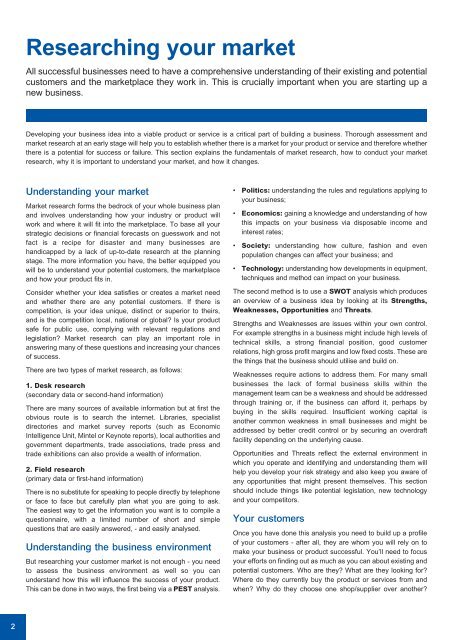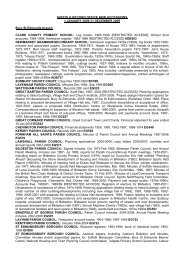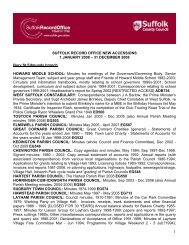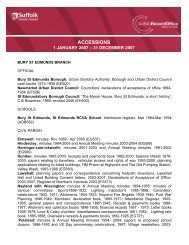starting and growing small business suffolk 06 12 11
starting and growing small business suffolk 06 12 11
starting and growing small business suffolk 06 12 11
- No tags were found...
You also want an ePaper? Increase the reach of your titles
YUMPU automatically turns print PDFs into web optimized ePapers that Google loves.
Researching your marketAll successful <strong>business</strong>es need to have a comprehensive underst<strong>and</strong>ing of their existing <strong>and</strong> potentialcustomers <strong>and</strong> the marketplace they work in. This is crucially important when you are <strong>starting</strong> up anew <strong>business</strong>.Developing your <strong>business</strong> idea into a viable product or service is a critical part of building a <strong>business</strong>. Thorough assessment <strong>and</strong>market research at an early stage will help you to establish whether there is a market for your product or service <strong>and</strong> therefore whetherthere is a potential for success or failure. This section explains the fundamentals of market research, how to conduct your marketresearch, why it is important to underst<strong>and</strong> your market, <strong>and</strong> how it changes.Underst<strong>and</strong>ing your marketMarket research forms the bedrock of your whole <strong>business</strong> plan<strong>and</strong> involves underst<strong>and</strong>ing how your industry or product willwork <strong>and</strong> where it will fit into the marketplace. To base all yourstrategic decisions or financial forecasts on guesswork <strong>and</strong> notfact is a recipe for disaster <strong>and</strong> many <strong>business</strong>es areh<strong>and</strong>icapped by a lack of up-to-date research at the planningstage. The more information you have, the better equipped youwill be to underst<strong>and</strong> your potential customers, the marketplace<strong>and</strong> how your product fits in.Consider whether your idea satisfies or creates a market need<strong>and</strong> whether there are any potential customers. If there iscompetition, is your idea unique, distinct or superior to theirs,<strong>and</strong> is the competition local, national or global? Is your productsafe for public use, complying with relevant regulations <strong>and</strong>legislation? Market research can play an important role inanswering many of these questions <strong>and</strong> increasing your chancesof success.There are two types of market research, as follows:1. Desk research(secondary data or second-h<strong>and</strong> information)There are many sources of available information but at first theobvious route is to search the internet. Libraries, specialistdirectories <strong>and</strong> market survey reports (such as EconomicIntelligence Unit, Mintel or Keynote reports), local authorities <strong>and</strong>government departments, trade associations, trade press <strong>and</strong>trade exhibitions can also provide a wealth of information.2. Field research(primary data or first-h<strong>and</strong> information)There is no substitute for speaking to people directly by telephoneor face to face but carefully plan what you are going to ask.The easiest way to get the information you want is to compile aquestionnaire, with a limited number of short <strong>and</strong> simplequestions that are easily answered, - <strong>and</strong> easily analysed.Underst<strong>and</strong>ing the <strong>business</strong> environmentBut researching your customer market is not enough - you needto assess the <strong>business</strong> environment as well so you canunderst<strong>and</strong> how this will influence the success of your product.This can be done in two ways, the first being via a PEST analysis.• Politics: underst<strong>and</strong>ing the rules <strong>and</strong> regulations applying toyour <strong>business</strong>;• Economics: gaining a knowledge <strong>and</strong> underst<strong>and</strong>ing of howthis impacts on your <strong>business</strong> via disposable income <strong>and</strong>interest rates;• Society: underst<strong>and</strong>ing how culture, fashion <strong>and</strong> evenpopulation changes can affect your <strong>business</strong>; <strong>and</strong>• Technology: underst<strong>and</strong>ing how developments in equipment,techniques <strong>and</strong> method can impact on your <strong>business</strong>.The second method is to use a SWOT analysis which producesan overview of a <strong>business</strong> idea by looking at its Strengths,Weaknesses, Opportunities <strong>and</strong> Threats.Strengths <strong>and</strong> Weaknesses are issues within your own control.For example strengths in a <strong>business</strong> might include high levels oftechnical skills, a strong financial position, good customerrelations, high gross profit margins <strong>and</strong> low fixed costs. These arethe things that the <strong>business</strong> should utilise <strong>and</strong> build on.Weaknesses require actions to address them. For many <strong>small</strong><strong>business</strong>es the lack of formal <strong>business</strong> skills within themanagement team can be a weakness <strong>and</strong> should be addressedthrough training or, if the <strong>business</strong> can afford it, perhaps bybuying in the skills required. Insufficient working capital isanother common weakness in <strong>small</strong> <strong>business</strong>es <strong>and</strong> might beaddressed by better credit control or by securing an overdraftfacility depending on the underlying cause.Opportunities <strong>and</strong> Threats reflect the external environment inwhich you operate <strong>and</strong> identifying <strong>and</strong> underst<strong>and</strong>ing them willhelp you develop your risk strategy <strong>and</strong> also keep you aware ofany opportunities that might present themselves. This sectionshould include things like potential legislation, new technology<strong>and</strong> your competitors.Your customersOnce you have done this analysis you need to build up a profileof your customers - after all, they are whom you will rely on tomake your <strong>business</strong> or product successful. You’ll need to focusyour efforts on finding out as much as you can about existing <strong>and</strong>potential customers. Who are they? What are they looking for?Where do they currently buy the product or services from <strong>and</strong>when? Why do they choose one shop/supplier over another?2
















